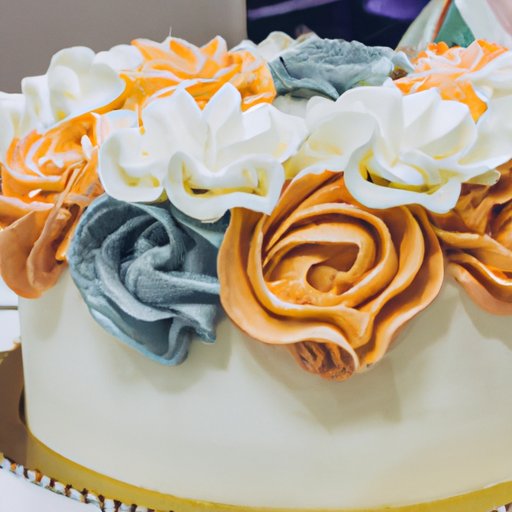
How to Make Buttercream: The Ultimate Guide to Perfect Frosting Every Time
Buttercream frosting is a delicious, versatile frosting that can be used for everything from filling cakes to decorating cupcakes and cookies. However, making the perfect buttercream can be tricky. With so many types of buttercream and variations in ingredients, it’s easy to become overwhelmed. This article is for anyone who wants to learn how to make buttercream frosting that is smooth, creamy, and delicious.

The Ultimate Guide to Making the Perfect Buttercream
There are four main types of buttercream frosting: American, Swiss, French, and Italian. Each type is made with a different technique and ingredients. American buttercream is the simplest and most common type, made with butter, powdered sugar, and vanilla extract. Swiss buttercream is smoother, made by whisking egg whites and sugar over a double boiler before beating in butter. French buttercream is richer, made with egg yolks, sugar, and butter. Italian buttercream is the most complicated, made with hot sugar syrup that is streamed into beaten egg whites before adding butter.
Buttercream is versatile and can be used for filling cakes, frosting cupcakes, spreading on cookies, or decorating with piping. Choosing the right type of buttercream for your recipe depends on the texture and sweetness you want. American buttercream is sweeter and firmer, while Swiss and French buttercream are smoother and have a more mellow taste.
When choosing butter for your buttercream, be sure to use unsalted butter that is at room temperature. Softened butter will create a smooth texture and prevent any lumps.
Five Simple Steps to Making Delicious Buttercream Frosting
Making buttercream frosting is easier than you might think. All you need are five simple steps!
- Cream the butter at room temperature until light and fluffy
- Sift the powdered sugar and add it to the butter in small increments, mixing thoroughly each time
- Add any flavorings, such as vanilla extract or cocoa powder, and mix until combined
- Gradually add liquid, such as milk or cream, until desired consistency is achieved
- Mix until smooth and creamy
Be sure to use a stand mixer or hand mixer to make sure your buttercream frosting has a smooth texture.
Mastering the Art of Buttercream: Tips and Tricks
If you want to take your buttercream frosting to the next level, try these tips and tricks from professional bakers and pastry chefs.
Flavors can be added through extracts, fruit purees, or spice blends. If you’re adding fruit or other flavors with a lot of moisture, be sure to add it to the buttercream slowly to prevent the frosting from becoming too soft.
To add color to your buttercream, use high-quality food coloring gel or paste. These won’t affect the consistency of the frosting.
If you’re decorating with buttercream, use a piping bag and tip for precision and detail. Make sure your frosting is the right consistency for the tip you’re using.
A Foolproof Buttercream Recipe for Beginner Bakers
If you’re new to baking and want a simple buttercream frosting recipe, try this one:
- 1 cup (2 sticks) unsalted butter, at room temperature
- 4 cups powdered sugar, sifted
- 1 teaspoon vanilla extract
- 2 tablespoons milk or cream
- Cream the butter until light and fluffy
- Gradually add powdered sugar, mixing thoroughly after each addition
- Add vanilla extract and 1 tablespoon of milk
- Mix until combined
- Add additional milk until desired consistency is achieved
For a chocolate version of this recipe, substitute 1/2 cup of cocoa powder for 1/2 cup of the powdered sugar.
Buttercream Frosting: How to Customize and Experiment with Flavors
Buttercream frosting is a blank canvas for flavor experimentation. Try popular combinations like lemon and lavender or raspberry and chocolate. If you’re adding fruit to your buttercream, use freeze-dried fruit instead of fresh to avoid adding too much moisture.
Herbs, such as mint and basil, can also add unique flavors to buttercream. Rinse and dry the herb leaves, then chop them finely before adding them to the frosting.
Buttercream 101: Ingredients, Techniques, and Troubleshooting Tips
To make the best buttercream, it’s important to understand the ingredients and techniques involved.
The main ingredients in buttercream are butter, powdered sugar, liquid, and flavorings. Be sure to use unsalted butter that is at room temperature and sift the powdered sugar to avoid lumps.
One common problem with buttercream is graininess, which can be caused by using too much sugar or not mixing the butter and sugar thoroughly. If your buttercream is too soft, try refrigerating it for 15-20 minutes before using it.
Separation is another issue that can occur when making buttercream. If this happens, keep mixing until the mixture comes back together.
If your buttercream is too soft or runny, try adding more powdered sugar until the desired consistency is achieved.
Conclusion
Making buttercream frosting can be intimidating, but with a little practice and patience, you’ll be making perfect frosting every time. Remember to experiment with different types and flavors of buttercream to find your favorite. Try using buttercream frosting to fill cakes, frost cupcakes, or decorate cookies and cakes with piping.
For more resources and recipes, check out baking blogs and YouTube tutorials.





